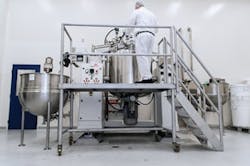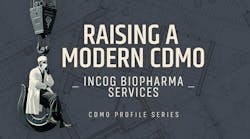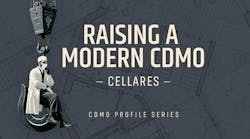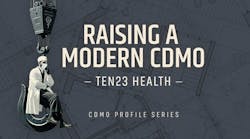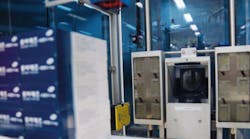Responsible drug manufacturers and contract organizations share the common goal of producing the best possible product in the most efficient way. The two have shared mutually beneficial relationships for decades in the pharmaceutical industry and will no doubt continue to do so for years to come. The numbers support that continued success as well: according to an IntelliROI 2016 report, the global contract pharmaceutical manufacturing market is expected to reach $84 billion by 2020, up from $58 billion in 2014.
What follows is an in-depth look at pharma’s outsourcing relationships from the contract manufacturing perspective — what works, what doesn’t, and how to both build and maintain the optimum dynamic for ongoing success.
One Size Does Not Fit All
When trying to qualify the relationships between contract organizations and their customers, generalizations are ill-advised. Asked about the challenges and frustrations of their client relationships, the resounding response from CMOs was — “it depends.”
Drug manufacturers have a broad range of outsourcing experience, and naturally some companies are better-versed in the process than others. Additionally, project complexity, scale, goals and timelines vary. However, in order for the process to run smoothly, it is pivotal that drug manufacturers do not lose sight of why they are outsourcing. Essentially, is the need functional or strategic or somewhere in between?
“I think it’s important for our potential customers to keep in mind why they went to a CDMO in the first place,” says Mike Valazza, VP global business development, Catalent Pharma Solutions. “Was it speed or technical advancements or a specific delivery platform, for example. If they keep that in the forefront of their minds, they will find a partner that is a good fit.”
Project complexity can change the nature of relationships as well. Drug manufacturers who approach contract organizations with products that are easy to make, with well-characterized processes and well-defined systems naturally create a smoother, simpler relationship. But complex pharmaceutical products are becoming increasingly more common.
“These complex products require a much higher level and frequency of communications as the CMO works through the various challenges that will be confronted. There needs to be mutual trust and responsiveness from both parties to get these challenges resolved quickly and efficiently,” says Lonnie Barish, executive director, business development, Wellspring Pharma Services.
Manufacturing semi-solids at WellSpring.
But just because the product is complex, does not mean the outsourcing relationship has to be complex, says Simon Edwards, VP global sales and business development, Cambrex. “The project may be complex, but relationships only get complicated by people. A good relationship is a bond based on the individuals who are involved. Where it gets complex is when there are people involved behind the scenes who aren’t active in the day-to-day interactions. If all those working directly together respect one another and develop a degree of goodwill, there is a natural tendency to sort out problems,” says Edwards.Strategic Partnership?
Much has been written about the role of contract manufacturers evolving from an “extra set of hands” to a more high-level, strategic partnership. But is the term “strategic partnership” truly the best way to describe the contract organization/drug manufacturer relationship? Again, the answer is: it depends.
“I don’t like the term strategic partners. It’s true that if it’s going to work well, the relationship should be strategic in nature. But we are definitely not talking about a formal strategic partnership on paper — it is more strategic behavior as opposed to a strategic partnership. The strategic behavior comes out of the relationship you build, not out of formalizing a strategic partnership agreement,” says Edwards.
Tee Noland, CEO of Pharma Tech Industries, echoes that sentiment and is realistic about the varying nature of the relationship.
A cleanroom producing powder-based Rx products at Pharma Tech Industries’ manufacturing facility in Royston, Georgia.
“The word ‘partnership’ just gets thrown around a lot,” says Noland. “The reality of some of our relationships can be ‘you’re the vendor and we are the customer,’ which can make solving problems and communication challenging,” acknowledges Noland.When drug manufacturers are content with working tactically — purchase order after purchase order — and aren’t seeking a strategic relationship, savvy contract organizations adapt to the situation.
“We tune our execution protocol to suit individual client requirements. Some of our longest partnerships have been with clients where we demonstrated flexibility and commitment to fine tune our approach to meet their needs,” says Vivek Sharma, CEO of Piramal Pharma Solutions.
Perhaps it’s a problem of logistics more so than semantics. It isn’t necessarily the case that the entire pharmaceutical industry is opposed to significant, high-level relationships with their outsourcing partners — but getting there can be a struggle.
Supply chain optimization is at the forefront of today’s pharmaceutical industry agenda, playing a key role in addressing current cost, performance and quality challenges. According to an A.T. Kearney Pharma Supply Chain Panel survey of pharmaceutical companies, the single biggest barrier to improving performance is supply chain complexity. And while 92 percent of respondents of that survey saw simplifying their supply chains as a strategic priority, nearly 40 percent of the surveyed firms were not yet doing anything about it.
“Many large pharma companies are in fact saying they want ‘strategic partnerships’ with CMOs. They don’t want to work with 150 CMOs, they just want the 50 best CMOs. But to get there is not an easy thing to do. There is a tremendous amount of time and complexity involved in shifting products in order to consolidate suppliers,” says Noland.
As drug manufacturers continue to pare down their vendor numbers and establish preferred/strategic partnerships with fewer, integrated suppliers, contract organizations are establishing competitive advantages by understanding the individual needs of each customer and maintaining a flexible approach to the relationship.
[javascriptSnippet]
Finding “The One”
The contract services market has enjoyed healthy growth in recent years, no doubt a reflection of the robustness of pharmaceutical pipelines and the drug industry’s overall greater need for support. In fact, Nice Insight’s 2016 CDMO Outsourcing annual survey revealed that pharma/biopharma execs expect spending on outsourcing to increase for the fourth year in a row.
However, consolidation, increasing offshore outsourcing alternatives and pharma’s tightening purse strings means that competition for outsourcing bids is alive and well — and pricing, like it or not, is a factor in contract services selection. But according to CMOs, it is not the leading factor in the process.
“I don’t think price dominates — it’s not necessarily the number one. Customers talk to at least 3-6 suppliers, and often kick out the highest and the lowest bid. If price was dominating, drug manufacturers would just pick the lowest bid,” points out Edwards.
So what is dominating the selection process? First and foremost, is a contract organization’s quality reputation, followed closely by its ability to execute projects against promised timelines.
“Customers do look at your quality record and do try to get a feel for your technical expertise. I don’t think I’ve ever won any business where our customers haven’t gone to look at our sites first,” says Edwards.
Sharma echoes this sentiment: “The degree of confidence that the CMO can provide to the customer on supplying the product on time, at the right quality, quite often directly correlates to the probability of winning the proposal. Of course, the CMO still needs to be within a certain range of the bids that the customer receives.”
Part of Catalent’s Pressurized Metered Dose Inhaler (pMDI) filling suite at RTP, North Carolina.
Upon further dissection, the “price” discussion should really be a discussion of value — exactly what are drug manufacturers getting for their dollars spent? “At the end of the day, the least expensive car on the market isn’t going to be a Mercedes, but if you are going to spend the money on a Mercedes, you are expecting that the value is there for what you are spending,” points out Valazza.Contract organizations caution drug makers against chasing lower numbers. And the precautionary words are not merely self-indulgent: Lower initial prices could ultimately equate to bad service, bad quality and supply disruptions.
“It is up to the pharma companies to decide if they want a reliable supply chain — one where they are not constantly having to put out fires — or do they want to chase a lower cost and, as a result, have to micromanage their supply chain,” says Noland.
Scope creep — a challenge ubiquitous to all project management — needs to be taken into consideration during the initial price screening. Scope creep occurs when a project is not properly defined, controlled or documented, and deliverables and project boundaries are not properly laid out.
It’s helpful to be aware that different contract organizations take different approaches to handling scope creep. “Some will come in with barebones project scope and then issue change orders as the project moves forward, while other companies will do more of a full-service proposal and lay out what they anticipate to be all the costs, preferring to minimize change orders,” explains Barish.
“It’s not always the case that others are less expensive; sometimes they just scope less work,” agrees Valazza.
“What we do at Catalent is to anticipate the work the client will need based on all our experience and build that into the proposal. We try to be upfront with what we think would be the best way to run the program if we were the decision maker,” Valazza adds.
As drug manufacturers narrow down their choices of outsourcing partners, thorough due-diligence and drilling down to understand how the project is truly going to run ultimately helps inform the decision much more than just figures on a page.
Planning Ahead
A new manufacturing plant at Cambrex's facility in Charles City, Iowa.
Contract organizations cannot stress enough the criticality of advanced planning. There is universal agreement that the clearer the vision for the project upfront, the smoother it will go down the road, and the opposite is equally true: poor planning will cost both sides time, money and frustration.“One of the leading causes for tension in the CMO/ pharma relationship is lack of clarity and vision upfront,” says Barish.
Planning needs to come from both sides of the relationship.
“Ideally pharma companies lay out exactly what they want, what their regulatory strategy is and how they see the project rolling out. Companies that do not provide the basic info for developing a quotation — safety data on APIs or packaging info for example — create a back and forth as contract organizations struggle to get all of the needed information. And ultimately, pharma companies can regret decisions that were made early on that were not strategically thought out upfront and instead decided on the fly,” says Barish.
When expectations are clearly defined upfront, contract organizations can then provide the pharma manufacturer with a clearer understanding of full cost and timelines.
“In general, customers are prepared. It is even more helpful if they are clear on the difference between what they want and what they need. Often drug manufacturers are looking to get to the next step, but the bigger question is, what do you NEED to get there?” says Edwards.
A widely used tool for laying out such expectations is the Request for Proposals (RFP). The RFP document should effectively communicate the pharma organization’s key deliverables and timelines in detail and ask questions specific to the proposed project.
“A well-written RFP and an effectively managed RFP process form the foundations for a productive relationship with the chosen CMO — a relationship that may last for the entire lifecycle of your product,” says Ron Herman, senior partner, NexGen Consulting Group. (For more on RFPs, see Herman’s The Art of the Request for Proposals .)
RFPs mean all potential outsourcing partners see the same package, at the same time. While it standardizes the playing field, there can be downsides to the on-paper process.
“RFPs tend to take the relationships out of a lot of sourcing decisions. I worked with Bob on the last project and it went really well, but Bob is now replaced by a RFP committee. On the one hand, it’s a way of doing things fairly, but it’s also a bit of a loss because it removes the relationship from the initial equation,” says Edwards.
Ideally, drug manufacturers reach back out to CMOs after receiving proposals, seeking further clarification and asking questions about the proposal. The personal relationship element should, at this point, re-enter the picture.
While a carefully written and thought-out RFP can take the human element out of the equation, “on another level it clarifies the direction, and does a better job of setting expectations on both sides,” concludes Barish.
The Nature of Working with Pharma
Each industry comes with its own unique set of challenges. Savvy contract organizations are well-versed in the struggles indicative of pharma and have established methods of working through these challenges.
One such challenge in the pharma industry is culture. As pharma’s business models shift, its cultural models are failing to adjust accordingly. Frequent mergers, acquisitions, and relocations further complicate the matter. PwC went as far as to use the term “cultural sclerosis,” stating that “prevailing management culture, mental models and strategies on which the industry relies are the same ones it’s traditionally relied on, even though they’ve been eclipsed by new ways of doing business.”
Companies struggling to build a strong culture within their own organizations will invariably be challenged when trying to form working partnerships.
“You need to be sure of your own culture before you can find a cultural fit with an outsourcing partner,” says Noland.
But this struggle has helped some contract organizations to reflect inward and work to improve their own cultures. A poor cultural fit can result in awkward CMO-drug manufacturer relationships, which means CMOs also need to have a clear vision of their own capabilities.
“Our reputation is paramount to us. If I take on a program that isn’t a good fit culturally and the customer has a bad experience, it can affect our ability to work with that customer on other programs in the future,” says Valazza.
Pharma Tech speaks of the time spent building their own cultural focus. “To get the culture we believe is in the shared interests of our employees and our customers, we’ve had to invest a lot in our cost structure in terms of the right leadership. To grow, we need a certain level of volume and profitability to sustain the culture we want,” says Noland.
Contract organizations can be challenged to take such a position, as the core reason for outsourcing has traditionally been lower costs — meaning CMOs have to exercise some frugality, at least at the start, and need to reach a certain scale before investing heavily in top talent. But the investments seemingly pay off, as contract organizations with strong cultures and values are able to provide structure and consistency to their customer relationships.
Communication, Flexibility and Planning
There is much variability involved in pharmaceutical outsourcing relationships and tremendous pressure surrounding these relationships.
“In our industry, time is money. Delaying the launch of a product can result in the loss of tens of thousands, sometimes millions of dollars. We, as CMOs, are constantly being reminded of that fact,” says Barish.
Building a good outsourcing relationship is the responsibility of both parties, and the best relationships have these three things in common: communication, flexibility and planning.
“Every project and customer is a learning experience. It’s a complex business to be in. The pace and challenges in the pharma world can be eye-opening,” concludes Noland.
For two sectors that rely on each other for industry success, mastering the art of building and maintaining relationships is proving to be worth it.
